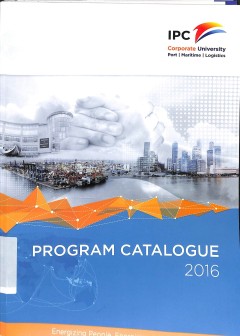Ditapis dengan

Program Catalogue 2016
- Edisi
- 2016
- ISBN/ISSN
- -
- Deskripsi Fisik
- 124 p.
- Judul Seri
- -
- No. Panggil
- IPC GUI PRO p C.1
- Edisi
- 2016
- ISBN/ISSN
- -
- Deskripsi Fisik
- 124 p.
- Judul Seri
- -
- No. Panggil
- IPC GUI PRO p C.1

Joint planning for yard storage space and home berths in container terminals
Yard planning is essential for efficient operations in container terminals, especially for ports with limited storage space. To improve the utilisation of space and the efficiency of container handling in a terminal, operators require flexible yard space planning strategies to manage job workloads and yard-to-berth transportation costs. In previous studies, the inter-related decision making pro…
- Edisi
- Vol. 51, No. 10, 3143–3155
- ISBN/ISSN
- -
- Deskripsi Fisik
- 14 p.
- Judul Seri
- International Journal of Production Research
- No. Panggil
- ATC LO KUN j

Integrated Storage Space Allocation and Ship Scheduling Problem in Bulk Cargo…
This study is motivated by the practice of large iron and steel companies, which have steady and heavy demands for bulk raw materials such as iron ore, coal, limestone and so on. These materials are usually transported to a bulk cargo terminal by ships (or to a station by trains). Once discharged, they are moved to and stored in bulk material stock yard, waiting for retrieval for production use…
- Edisi
- -
- ISBN/ISSN
- -
- Deskripsi Fisik
- 45 p.
- Judul Seri
- IIE Transactions
- No. Panggil
- ATC LO TAN i

A yard storage strategy for minimizing traffic congestion in a marine contain…
This paper studies a storage yard management problem in a transshipment hub where the loading and unloading activities are both heavy and concentrated. In order to reduce the number of reshuffles, which helps to reduce the vessel turnaround time, the port operator uses the consignment strategy to group export and transshipment containers according to their destination vessel. To reduce the pote…
- Edisi
- 16 February 2008
- ISBN/ISSN
- -
- Deskripsi Fisik
- 24p
- Judul Seri
- A yard storage strategy for minimizing traffic congestion in a marine container transshipment hub
- No. Panggil
- ATC LO HAN a

A mixed-integer programming model for global logistics transportation problems
In today’s highly competitive global environment, companies are forced to compete on price and delivery speed. Global logistics transportation presents some special challenges and issues for business organizations, and these issues differ from those posed by domestic logistics transportation. This study considers road transportation problems between two countries. A mixed-integer programming …
- Edisi
- Vol. 39, No. 3, March 2008, 217–228
- ISBN/ISSN
- 0020–7721
- Deskripsi Fisik
- 13 p.
- Judul Seri
- International Journal of Systems Science
- No. Panggil
- ATC LO WUY a

An optimization model for storage yard management in transshipment hubs
This paper studies a yard storage allocation problem in a transshipment hub where there is a great number of loading and unloading activities. The primary challenge is to efficiently shift containers between the vessels and the storage area so that reshuffling and traffic congestion is minimized. In particular, to reduce reshuffling, a consignment strategy is used. This strategy groups unloaded…
- Edisi
- -
- ISBN/ISSN
- -
- Deskripsi Fisik
- 23 p.
- Judul Seri
- REGULAR ARTICLE
- No. Panggil
- ATC LO HAN a

A continuous berth template design model with multiple wharfs
Berth planning plays an important role in improving the efficiency of a container terminal. This study focuses on the berth template problem (BTP), which determines the berthing windows of the calling ships within a planning horizon (e.g. a week) in a cyclical way. As a mid-term tactical decision problem, BTP provides the decision support for a terminal operator to negotiate the contracts with …
- Edisi
- -
- ISBN/ISSN
- 0308-8839
- Deskripsi Fisik
- 14 p.
- Judul Seri
- The flagship journal of international shipping and port research
- No. Panggil
- ATC LO HUA a

Integrated berth allocation and quay crane assignment problem : set partition…
Most of the operational problems in container terminals are strongly interconnected. In this paper, we study the integrated Berth Allocation and Quay Crane Assignment Problem in seaport container terminals. We will extend the current state-of-the-art by proposing novel set partitioning models. To improve the performance of the set partitioning formulations, a number of variable reduction techni…
- Edisi
- -
- ISBN/ISSN
- -
- Deskripsi Fisik
- 23 p.
- Judul Seri
- -
- No. Panggil
- ATC PO LAR i

Impacts of business environment changes on global manufacturing outsourcing i…
Rising production costs in coastal China have caused the popularity of the “China plus one” strategy, and the hike in oil prices favors nearshore outsourcing to reduce transportation costs. Taking into consideration supply chain strategy, this paper aims to investigate the impacts of these major business environment changes on manufacturing outsourcing in China.
- Edisi
- Volume 17 · Number 2 · 2012 · 138–151
- ISBN/ISSN
- -
- Deskripsi Fisik
- 16 p .
- Judul Seri
- Supply Chain Management: An International Journal
- No. Panggil
- ATC LO HUA i
 Karya Umum
Karya Umum  Filsafat
Filsafat  Agama
Agama  Ilmu-ilmu Sosial
Ilmu-ilmu Sosial  Bahasa
Bahasa  Ilmu-ilmu Murni
Ilmu-ilmu Murni  Ilmu-ilmu Terapan
Ilmu-ilmu Terapan  Kesenian, Hiburan, dan Olahraga
Kesenian, Hiburan, dan Olahraga  Kesusastraan
Kesusastraan  Geografi dan Sejarah
Geografi dan Sejarah